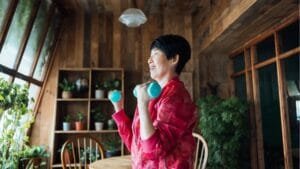
When I was growing up, my mom always reminded me how important it is to have enough calcium for healthy bones. That might seem odd, but she knew we had a family history of osteoporosis and wanted me to be strong and healthy.
As a non-diagnosed lactose intolerant kid before there were so many dairy alternatives, along with an inability to take big pills, I felt like there wasn’t much I could do to follow these instructions to get enough calcium and build my bones.
As an adult, I have worked for years in Physical Therapy. I started my own fitness coaching programs for women and men over 55 almost 8 years ago. Throughout my career, I have made a conscious effort to learn as much about osteoporosis and bone health as I could since I want to provide my clients with the very best support. I have learned that there is so much more to building bone density including nutrition, lifestyle, and exercises.
With a disease so prevalent, 54 million Americans are affected, it is alarming that there is still some misinformation and lack of education regarding osteoporosis and bone health.
Just a few weeks ago, my husband shared that his coworker was diagnosed with osteoporosis, and she spoke as if it was a death sentence and that she had to stop doing any activity, which is absolutely not true!
Exercise can help to prevent further bone loss, build stability, improve your balance, and keep you strong. Let’s uncover the exercises that can help you to build your bone density and exercises to avoid.
The Truth About Weight Bearing Exercise
It is possible to build bone density and prevent further deterioration at every stage of life. Weight bearing exercises are important for building bone density. Through the principle of Wolff’s law, our bones will adapt, remodel, and strengthen with more stress placed on them.
Exercises in the water, swimming, and biking are not weight bearing exercises, while they may be helpful for your joints, they will not help to build and prevent bone density loss. Walking and yoga are also not enough exercise to help build your bone density, especially if you are a regular walker.
If you walk regularly, your body is used to the challenge of walking, and therefore, this activity is not enough of a stress or challenge to build bone density.
Challenge yourself if you are a regular walker by using a weighted vest while walking to improve bone health, be sure to maintain great posture and avoid the tendency to lean forward too far while walking.
Impact Exercises Can Help to Build Bone Density
If you have healthy joints and have not yet been diagnosed with osteopenia or osteoporosis, you can add some impact exercise to build your bone density. Beyond my mom’s advice for calcium, and if we had known more, adding impact exercise as a kid is a great way to ensure you build bone density, as most of our bone growth peaks in our 30s.
Kids should do martial arts, gymnastics, jump rope, and impact exercises to keep their bones strong. As we age, often we hear about “low impact” exercises which are often helpful for joint issues, but to build bone density we need some impact. Try these exercises if you have healthy joints and are not diagnosed with osteoporosis:
Exercises to Avoid with Osteoporosis or Osteopenia
If you have been diagnosed with osteoporosis, there are some exercises and movements in daily life that you should avoid. Avoid the combination of bending, lifting, and twisting, such as reaching and twisting to pick up a heavy bag of groceries. Instead, turn and face the object, square off, and bend at your hips and knees to pick up safely.
You will also want to avoid crunches as they put too much pressure on the spine. Avoid deep bending or flexion and extension past neutral exercises at the spine, especially under tension, using weight, or for a prolonged period of time. Examples of these are child’s pose in yoga (deep flexion), or sphinx pose (deep extension), these movements can be modified for less stress on your spine.
Exercises to Build and Maintain Bone Density and Bone Health
Posture and Stability
It is important to build strength in your spinal extensor muscles to maintain good posture and build stability in the spine.
Here are 3 exercises to help build your spinal extensors and protect your spine to help you build stability:
Strength Training
Strength training exercises are so important to build bone density. Be sure to keep good form and a neutral spine, start slow to ensure good technique, and then gradually increase your weights. Your body needs the challenge to build bone density, lift weights where you can still maintain good form but heavy enough to give you a challenge by the last few repetitions.
Aim for 2-3 strength training workouts a week focusing on the major muscle groups such as glutes, mid back, and quads. When possible, aim for standing exercises with free weights versus seated machines to work your muscles in a more functional pattern and add some dynamic stability.
In this video I show 3 strength training movements that can help you to build bone density:
Balance
Maintaining good balance is also a critical part of bone health. If you have bones that are brittle, having a fall could cause a fracture. Unfortunately, falls often lead to hospitalizations and can lead to health spiraling downwards.
Balance exercises are more than just standing on one foot or static balance. Balance training includes reaction time training like catching a ball, pickleball, tennis, stepping and agility or quick movements, strength training to build strong muscles and your core, mobility and stretching to maintain flexibility, and static balance, like the ability to stand on one foot.
In this video, I will demonstrate some exercises to help improve your balance:
Let’s Have a Conversation:
What is the state of your bones? Have you received a recent diagnosis of osteoporosis? What do you do to keep your bones strong and healthy? Have you heard of exercises to avoid?





